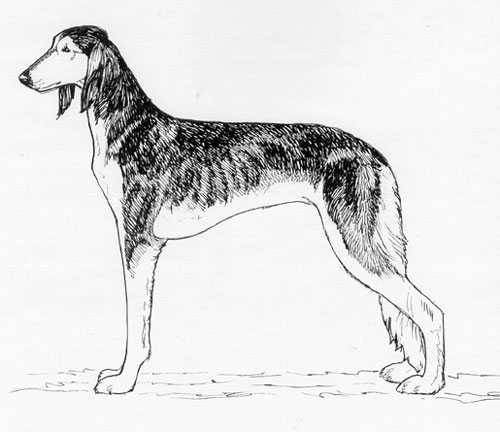Saluki
Sighthound & Pariah Dog Group
The goals and purposes of this breed standard include: to furnish guidelines for breeders who wish to maintain the quality of their breed and to improve it; to advance this breed to a state of similarity throughout the world; and to act as a guide for judges.
Breeders and judges have the responsibility to avoid any conditions or exaggerations that are detrimental to the health, welfare, essence and soundness of this breed, and must take the responsibility to see that these are not perpetuated.
Any departure from the following should be considered a fault, and the seriousness with which the fault should be regarded should be in exact proportion to its degree and its effect upon the health and welfare of the dog and on the dog’s ability to perform its traditional work.
History
The Saluki is one of the oldest known breeds and has existed for thousands of years. It was originally bred and owned by Arab tribesmen, who used its sighthound abilities for hunting. Considered a sacred gift from God, Salukis were never sold but given as an honored gift.
The Saluki was recognized by the United Kennel Club in 1956.
General Appearance
The overall appearance and impression of the Saluki is one of grace and symmetry, along with great speed and endurance coupled with strength and activity. Salukis vary in type and this variation is typical of the breed due to the immense size of the Middle East area where the breed has been used for hunting for thousands of years. Each tribe had Salukis that were best suited for hunting the particular game in their region, and it follows that the dogs that were presented to Europeans and brought to Europe were from a wide variety of terrain and climate, and therefore vary accordingly.
Characteristics
The Saluki is dignified, intelligent and independent. They are reserved with strangers, but never shy or aggressive.
Head
The head is long and narrow, and has the look of nobility.
SKULL
The skull is moderately wide between the ears and not domed. The stop is not pronounced.
MUZZLE
The jaws are long and strong.
TEETH
A full complement of strong, white teeth meet in a scissors bite.
EYES
The bright, oval-shaped eyes are large, but not prominent. In color, they are dark to hazel. The expression is dignified and gentle with faithful, far seeing eyes.
NOSE
Nose pigment is black or liver.
EARS
The long, mobile ears hang close to the skull. They are covered with long, silky hair.
Neck
The long neck is well muscled and supple.
Forequarters
The sloping shoulders are well laid back. They are well muscled, but not coarse. The upper arms are approximately the same length as the shoulder blades and form a good angle with them.
FORELEGS
The forelegs are straight and long from the elbow to the wrist (carpus). The pasterns are strong and flexible with a slight slope.
Body
In proportion, the Saluki is approximately square when measured from the point of the shoulders to the point of the buttocks, and the top of the withers to the ground. The chest is deep, long and moderately narrow. The ribs are moderately sprung. The back is fairly broad, and the loin is well muscled and slightly arched. The hipbones are set wide apart. The underline is well tucked up.
Hindquarters
The hindquarters are strong, showing galloping and jumping power.
HIND LEGS
The upper and lower thighs are well developed. The stifle is moderately bent. The hocks are low to the ground.
Feet
The strong, supple feet are well feathered between the toes. The feet are of moderate length, not cat footed; with long, well-arched toes.
Fault: Splayed toes.
Tail
The long tail is set on low and is carried naturally in a curve. It reaches at least to the hock. It is well feathered with long, silky hair on the underside; not bushy. In adults, the tail is not carried above the line of the back, except in play.
Coat
The coat is smooth and has a soft, silky texture. There is feathering on the backs of the front legs and on the rear of the thighs. In adults, there may be feathering on the throat. Puppies may have a slightly woolly feathering on the thighs and shoulders. The smooth coated variety has no feathering.
Color
Any color or combination of colors is permissible, with the exception of brindles, which are undesirable.
Disqualification: Albinism.
Height
Dogs average in height from 23 to 28 inches. It is breed typical that females may be considerably smaller.
Disqualifications
(A dog with a Disqualification must not be considered for placement in a conformation event, and must be reported to UKC.)
Unilateral or bilateral cryptorchid.
Viciousness or extreme shyness.
Albinism.

Looking for a Dog?
Find a dog that will fit your family.
Note: The breeders on this list are not endorsed by UKC.
Revised May 1, 2008
©Copyright 1992, United Kennel Club
